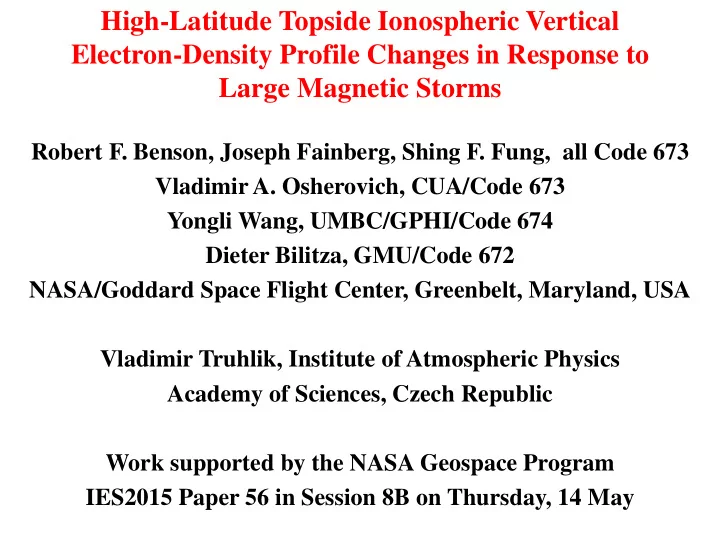

High-Latitude Topside Ionospheric Vertical Electron-Density Profile Changes in Response to Large Magnetic Storms Robert F. Benson, Joseph Fainberg, Shing F. Fung, all Code 673 Vladimir A. Osherovich, CUA/Code 673 Yongli Wang, UMBC/GPHI/Code 674 Dieter Bilitza, GMU/Code 672 NASA/Goddard Space Flight Center, Greenbelt, Maryland, USA Vladimir Truhlik, Institute of Atmospheric Physics Academy of Sciences, Czech Republic Work supported by the NASA Geospace Program IES2015 Paper 56 in Session 8B on Thursday, 14 May
Motivation Radio Plasma Imager (RPI) magnetospheric measurements from IMAGE near-apogee over the polar cap during the great magnetic storm of 31 March 2001 revealed: Large magnetospheric electron-density Ne enhancements (~ X 16) Moderate magnetospheric magnetic-field magnitude |B| enhancements (~ X 2) Highly correlated fluctuations in solar-wind and magnetospheric parameters (with 3 hour time lag) [Osherovich et al., JGR, 2007] Above results based on in-situ RPI-stimulated plasma resonances IMAGE ~ 8 R E radial distance above the northern polar cap During the same storm, RPI field-aligned echoes indicated strongly enhanced polar-cap Ne profiles down to ~ 4 R E radial distance [Tu et al., JGR, 2007] Goal Investigate Alouette/ISIS high-latitude topside-sounder data during large magnetic storms and attempt to relate Ne(h) changes to solar-wind parameters
Approach 125 large magnetic storms (minimum Dst < -100) were identified in the 1965 - 1985 interval when both solar-wind and Alouette/ISIS topside-sounder data were potentially available from the NASA/GSFC Space Physics Data Facility (SPDF) http://spdf.gsfc.nasa.gov/ Many had > 100 high-latitude topside electron-density profiles Ne(h) or ionograms 10 storms were investigated 5 had Ne(h) in the northern hemisphere; 5 had Ne(h) in the southern hemisphere Here we report on 4 northern hemisphere cases that also had good solar-wind data The large topside Ne(h) profile database allowed groups of profiles to be collected from the same small space/time region before, during and after each storm These groups were examined for storm-induced Ne(h) profile differences These differences were compared with time-shifted solar-wind parameters The estimated appropriate time shift of the solar-wind parameters was determined in the IES2015 companion paper by Osherovich & Fainberg (#47 in Session 9B)
Dst & topside Ne(h) for Magnetic storms of 1969_32 – 39 (top) & 38 – 49 (bottom) Above topside Ne(h) from manual-scaling of 35-mm film ionograms in the 1960s & 70s
Dst & topside Ne(h) for Magnetic storms of 1969_080–088 (top) & 1979_114– 118 (bottom) Ionograms for profiles 1b, 2a, 2b, 3, and 6 illustrated on next slide Topside Ne(h) from manual-scaling of digital ionograms from ISIS 1 (top) & ISIS 2 (bottom)
Selected ISIS-1 profile 1b ionogram FF = ionograms used to before storm 1.95 1.95 obtain Ne(h) profiles 082_0228:15 UT before, during & after magnetic storm of profile 2a ionogram 1969 _082.8 near Dst minimum upper-hybrid resonance 083_0340:33 UT Note echo changes profile 2b ionogram between ionograms 2a near Dst minimum & 2b (separated by 28 s) 083_0341:01 UT Note appearance & profile 3 ionogram disappearance of upper- early recovery hybrid resonance within 084_0313:23 UT ionogram 2a during ~ 4 s of fixed-frequency sounding at 1.95 MHz profile 6 ionogram after storm 087_0151:29 UT Above indicates high Swept frequency 0.1 – 20 MHz spatial and/or temporal Ne gradients during Dst minimum
Spring Winter Ne(2)/Ne(1) vs. Vsw Ne(2)/Ne(1) vs. Bsw
Spring Winter Ne(2)/Ne(1) vs. (By)sw Ne(2)/Ne(1) vs. (Bz)sw
Summary • Northern-hemisphere topside Ne(h) profiles analyzed for 4 large magnetic storms • Ne profiles compared in similar spatial regions before, during, and after storm • Large storm-induced Ne increases (decreases) observed during night (day) • Winter nighttime increases at 1100 km approached a factor of 10 • Spring daytime decreases at 550 km approached a factor of 1/10 • Large spatial and/or temporal Ne gradients observed during Dst minimum • Ne storm-induced changes compared with solar-wind v, B, By, & Bz time shifted by 0.15 day from Ne profile #2 time in each case [Osherovich & Fainberg IES2015 #47] • Ne changes during winter night increased with increasing v, B, –By, and –Bz • Ne changes during winter day increased only with increasing v, and –By • Ne changes during spring day increased only with increasing –Bz • Thus in these storms, with good background control, • –Bz appears to be the most important parameter in spring daytime • v and –By are the important parameters in winter daytime • and v, B, –By, and –Bz during winter night
ISIS 2 OTT digital ionogram1974_259 1322:22 UT Illustration of obtaining Ne profile from topside ionogram Scale X-trace ionospheric reflection from ionogram (a) Use inversion program [Jackson, IEEE, 1969] to obtain Ne(h) (b) (a) Use Ne(h) to calculate O-trace ionospheric reflection and compare with scaled O trace to check inversion procedure (c) (c) (b)
Recommend
More recommend